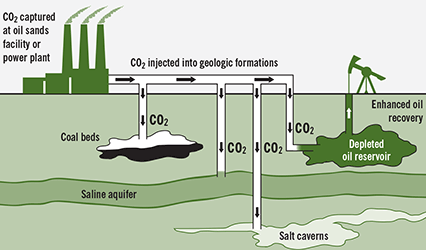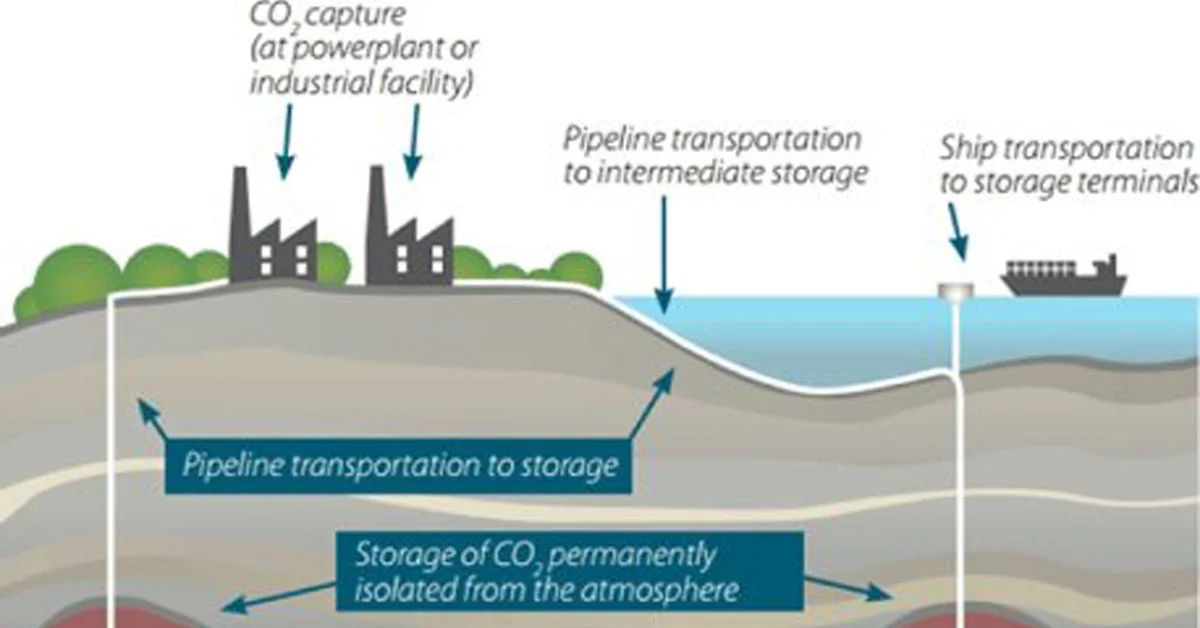Carbon capture and storage (CCS) encompasses a range of control methods designed to trap carbon dioxide emissions from significant industrial sources. Its purpose is to prevent CO2 from being released into the atmosphere, contributing to the worsening climate crisis. This technology can serve as a transitional solution, enabling the ongoing use of fossil fuels for electricity generation and industrial operations while we explore low-carbon alternatives.
This process includes the capture of CO2 emissions at their source, followed by transportation and eventual storage or burial in a suitable underground site. Typically, initial measures include installing solvent filters in factory chimneys to contain carbon emissions. The captured gas is subsequently transported to a destination where it can be either utilized or preserved.
Most of the CO2 emissions will be injected deep underground and become a part of the process called enhanced oil recovery where remaining pockets of oil, which are otherwise difficult to extract, are forced out by pumping CO2 into an oilfield. On the other hand, carbon emissions can also be used in growing greenhouse plants, making plastics and even carbonating fizzy drinks.

Need for Carbon Capture
According to facts stated by International energy Agency (IEA), CCS projects can help in decreasing the global carbon emissions by nearly a fifth of the actual emission rate. In addition to this, the cost for tackling climate crisis can be reduced by 70%. There are many potential benefits of carbon capture which include
• Supplementary power generation
Carbon dioxide based steam cycles in which CO2 is compressed into a supercritical fluid help turbine engines run efficiently by transferring more heat readily and lesser utilization of energy to compress steam. In addition to that, geologically stored CO2 can produce renewable geothermal energy by extracting geothermal heat from the same location from where it is injected.
• Bolster manufacturing
Carbon emissions can be used to make a variety of chemicals including plastics such as polyurethanes that are used in the manufacturing of soft foams utilized in mattresses.
• More fuel
There are a multiple ways of converting CO2 into a fuel. However, this is associated with process and cost constraints.
• New jobs
New jobs will be created as more skilled technicians will be required for the management of CSS operations
• Concrete enrichment
Captured carbon emissions can be used for the strengthening of concrete that ultimately leads to infrastructure stability.
Methods for Capturing CO2
The main methods of capturing carbon emissions include post-combustion, pre-combustion and oxy-fuel combustion.
1. Post-combustion
Post-combustion technology, after the burning of fuel, separates CO2 from flu gas via chemical solvents.
2. Pre-combustion
Pre-combustion methods involve converting the fuel into a gas mixture composed of CO2 and hydrogen before burning. After the burning of fuel, carbon emissions are separated and the remaining hydrogen rich mixture can be used as a fuel as well.
3. Oxy-fuel combustion
Oxy-fuel technology burns fuel with pure oxygen that in turn generates CO2 and steam with released CO2 subsequently captured. Post-combustion and oxyfuel combustion technologies can be easily fitted to new plants as well as existing facilities that were built without these control technologies. However, pre-combustion equipment need larger modification in the operations of a facility and are preferably more suitable for new plants.
At present, CCS fitted operational plants can capture around 90% of carbon emissions present in flu gas. Once captured, CO2 is compressed into liquid state and transported via pipelines, ships or road tanker to suitable deep geological formations, usually 1 km or more deep, for permanent storage in depleted gas or oil reservoirs, deep saline aquifers or wherever the geology is suitable. Alternatively the captured CO2 can be used for the production of commercial products and services.
Potential of CSS for Tackling Climate Change
Carbon capture, usage and storage plays a critical role in global decarburization in various ways. These include;
- Reduction of emissions in industries that are difficult to decarbonize. These include iron, steel, chemical and cement industry that alone is producing about 7% of total emissions globally.
- Production of low-carbon electricity and hydrogen that in turn can be used to decarbonize various activities. Low carbon electricity can replace fossil fuels in as an energy source in personal transport and space heating. Whereas hydrogen on the other hand can be a direct substitute of fossil fuels in combustion processes in industrial application and long haul transport.
- Removal of existing CO2 from atmosphere via direct air carbon capture and storage (DACCS) and bioenergy with carbon capture and storage (BECCS). Both these technologies have similarities with CCS. Former enables direct capture of CO2 from atmosphere while the later removes CO2 on a net basis with sustainably sourced biomass.
Significant Concerns around CCS
Cost is the biggest weakness around CCS technologies. However, it is expected that the cost will decrease as the technology develops and market expands given carbon prices increasing exponentially leaving no options other than reduction of emissions at any cost. Leakages of Carbon emissions from storage facilities is another environmental concern leading to reversal of intended emissions savings.
However, majority of storage sites are well understood geological formation sites that have stored CO2 for millions of years leading to relatively smaller leakage risks. In addition to that strong regulations are being developed for management and monitoring of storage sites.
Implementing an integrated wastewater treatment system in rural areas not only enhances water quality but also serves as a pivotal step towards environmental stewardship, harmonizing with Carbon Capture and Storage to create a comprehensive approach for sustainable development.
Water care services Pakistan always working to mitigate on every step of climate change and water treatment related concerns. Join our hands, and lets make world more cleaner, greener & sustainable.
You can Follow us on Facebook , Twitter , Linked in , you tube , and instagram .

